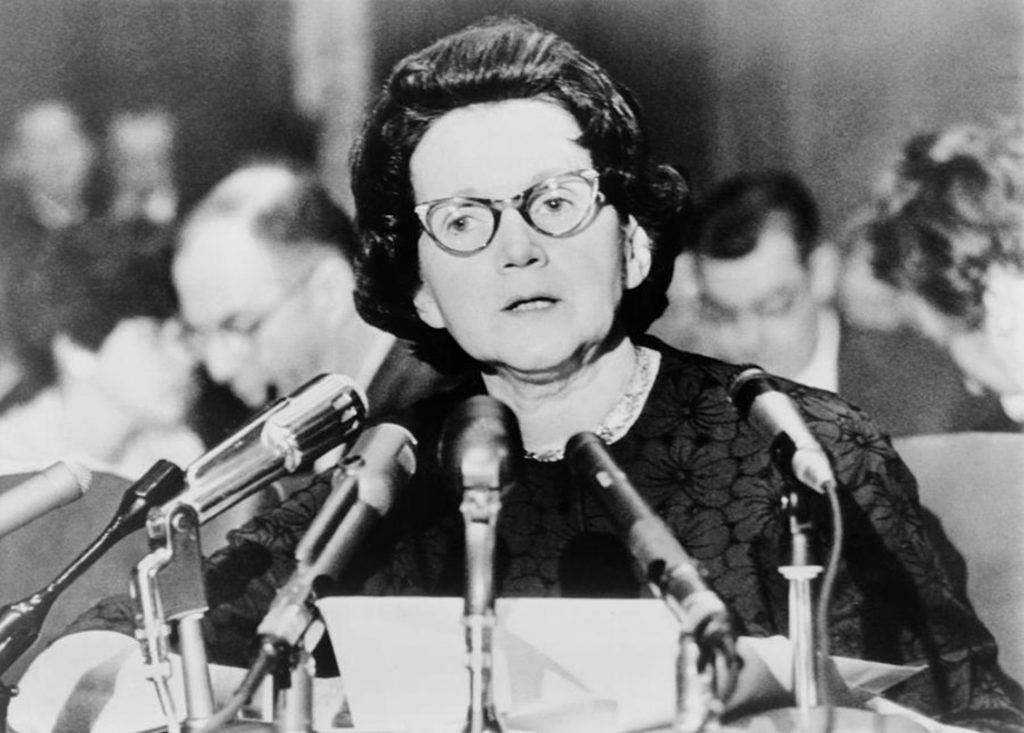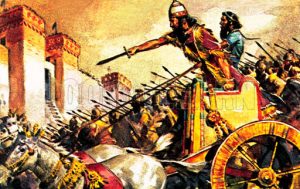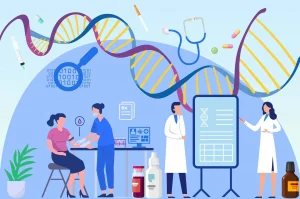In January 1958, marine biologist Rachel Carson received a letter in the mail from her distressed friend, Olga Huckins. The letter described a horrible scene. Olga woke up to fish, crabs, and many of her favorite birds dead and dying throughout her two acre bird sanctuary. The culprit? DDT.1
DDT, or Dichlorodiphenyltrichloroethane, is a potent insecticide that first gained popularity during World War 2, when it was used to shield millions of soldiers and civilians from insect-borne diseases like typhus and malaria. Following the war in 1945, DDT was brought back home as a solution to insect-borne diseases throughout the country. DDT was treated by many as a miracle poison, a magic insect killer that had limitless potential. Scientists around the United States presented DDT as an efficient way to eliminate dangerous imported insects and as a cheaper solution to control unwanted pests. It had the potential to not only protect civilians from insect born disease, but also to improve our crop yields and in turn improve the U.S economy. Herbicides and pesticides were not new to this time, but the tremendous volume of DDT that was being administered around the country was unmatched.2

Rachel Carson already had a successful professional career upon receiving the letter from her friend, as she spent her professional life leading up to this working as a marine biologist and as a two-time best selling author. Alongside her success in her own books, she was also regularly featured in environmental magazines. While she worked with the U.S. Fish and Wildlife service, Carson learned a lot about the environment. More importantly, her government position allowed her to observe internal debates about pesticides and how dangerous they could be, so the potential danger was already on her radar. The letter from her friend was the last straw, and Carson was not going to ignore the hazard any longer.3 Carson actually attempted to shed light on DDT and its undesirable effects shortly after it became available for civilian use, but the magazine she wrote for turned her down. Over a decade later and after reading Huckins’ letter, she attempted to get another article published, but was again turned down. At this point in time, Carson was already a reputable writer and credible scientist, so her inability to get this story out to the public indicates how combative the media was already being towards her narrative. Although she was unsuccessful in delivering her story to the public through popular magazines, Carson had amassed an immense amount of research up to this point—enough for her to put together a book of her own.4

After four additional years of research, writing, and editing, Silent Spring was born. Published in 1962, Silent Spring discussed the environmental damage that DDT was causing, while also addressing the misinformation that was being pushed by chemical companies and how it was putting people at risk. She urged readers to realize that people were capable of doing great damage to the environment, and in the case of DDT, we were. Synthetic pesticides like DDT are designed to kill pests, but the problem is that they often do harm to everything they come in contact with. DDT sprays undoubtedly did an exceptional job of killing insects, but there is no denying that it harmed many other organisms that interacted with those same areas where it was applied.5 Within two weeks of its publishing, Rachel Carson’s new book made its way to best sellers lists. DDT had become a normal part of everyday life, and the possibility that it was doing the harm she described really caught the attention of the public. DDT was quite literally being administered by the truckload.6

Compared to 200,000 pounds in 1943, almost 13 million pounds of DDT were produced during only the first five months of 1945. The misled public welcomed the potent insecticide with open arms. It was sprayed in neighborhoods, swimming pools, and even in diners—while people were eating.7 She not only grabbed the attention of the public, but she also attracted attention from the Chemical industry, who were not as welcoming. DDT was growing in popularity, and cities all around the country were adopting it, so there was money to be made here. Naturally, some of the biggest DDT defenders and Silent Spring critics were associated with the big chemical industry. Being a woman in the scientific community during this time was a challenge already, and her perseverance in spreading the word about DDT’s danger invited the aggressive opposition. The chemical industry not only continued to spread disingenuous information about DDT and its effect on people and wildlife, but in response to her book, they began to attack Carson personally. They released public statements that suggested she was not credible scientifically, and also proposed that she was presenting an “emotional” rhetoric. The central argument against the ideas she presented in her book were that she was cherry-picking negative stories about DDT and that it was mostly safe and overall a positive thing. They also expressed that DDT had become an essential aspect of public safety and it was important to continue implementing it.8
Carson received scrutiny from several organizations, notably from Velsicol Chemical Corporation of Chicago, American Agriculturist, Chemical and Engineering News, Monsanto Chemical Company, and Nutrition Foundation of New York City. Some of these companies went as far as threatening to remove their advertisements from magazines if they reported in Carson’s favor. 9 Regardless of the efforts of her opposition, Silent Spring moved the controversy of DDT into the public. On June 4, 1963, Rachel Carson spoke before the senate government operations subcommittee to discuss the issues revolving around pesticides. She expressed that our use of them was unsafe and the repercussions were unknown. She explained that what we were doing with DDT could cause irreversible environmental damage along with unknown damages to human health.10
Carson received several awards in the months following her testimony, along with support worldwide. Rachel Carson’s battle with big chemical industries is an impressive feat, as a woman in science and as an independent body going up against a massive industry. Her battle to ensure safety for the public was even more of an uphill struggle than the public realized, as Carson was battling cancer throughout her efforts. On April 14, 1964, Rachel Carson passed away in her home. Although she was gone, the work she left behind continued to progress towards the cause.11 Her accomplishments sparked a movement that promoted the responsible use of pesticides and the careful evaluation of the chemicals we release onto our lands. As a result, in 1970, the Environmental Protection Agency (EPA) was created. In 1972, the EPA successfully outlawed DDT in the United States. Today, the EPA aims to prevent pollution, reduce public health risks, conduct environmental research, develop pollution regulations, enforce environmental regulations, and educate the public on environmental policy and science.12

Rachel Carson was not the first person to question the safety of DDT, but her eloquent writing and scientific knowledge made her the perfect match for the large and powerful entities who wanted DDT to stick around. Although she did not live to see DDT’s abolishment, nor did she witness the creation of the EPA, I am confident that she knew the movement she started would continue to do great things after her passing. Her legacy serves as a model of environmentalism, and as an example of perseverance that is truly inspiring.
- Mary A. McCay, Rachel Carson (New York, NY, Twayne Publishers: Twayne’s United States Authors Series 619, 1993), 66. ↵
- Thomas R. Dunlap, DDT: Scientists, Citizens, and Public Policy (Princeton, New Jersey: Princeton University Press, 1981), 1. ↵
- Linda J. Lear, Rachel Carson’s “Silent Spring” (Environmental History Review 17, 1993) 27. ↵
- Mary A. McCay, Rachel Carson (New York, NY, Twayne Publishers: Twayne’s United States Authors Series 619, 1993), 67. ↵
- Rachel Carson, Silent spring (Boston : Houghton Mifflin, 1994), 76. https://library.uniteddiversity.coop/More_Books_and_Reports/Silent_Spring-Rachel_Carson-1962.pdf. ↵
- Robert K. Musil, Rachel Carson and Her Sisters: Extraordinary Women Who Have Shaped America’s Environment (New Brunswick; New Jersey; London: Rutgers University Press, 2014), 89. ↵
- Thomas R. Dunlap, DDT: Scientists, Citizens, and Public Policy (Princeton, New Jersey: Princeton University Press, 1981), 61, 65. ↵
- Terence Kehoe and Charles Jacobson, Environmental Decision Making and DDT Production at Montrose Chemical Corporation of California (Enterprise and Society 4, no. 4 December 1, 2003): 654–655. ↵
- Mary A. McCay, Rachel Carson (New York, NY, Twayne Publishers: Twayne’s United States Authors Series 619, 1993), 80. ↵
- Rachel Carson Council, Rachel Carson’s Statement before Congress 1963 (June 4, 1963), https://rachelcarsoncouncil.org/about-rcc/about-rachel-carson/rachel-carsons-statement-before-congress-1963/. ↵
- Linda J. Lear, “Rachel Carson’s ‘Silent Spring,'” Environmental History Review 17, no. 2 (1993): 40-42. ↵
- Teresa C. Donkin, Environmental Protection Agency (EPA), The Gale Encyclopedia of Environmental Health, Vol.1, 276-279. ↵



8 comments
Carlos Hinojosa
This was a great movement that helped our world for the better with the pesticides now gone it will be a lot safer for people to eat the food that so many people live on and feed upon. I wasn’t around for this movement obviously, but I still think it was a great message that would have survived even into our time and probably would have done even better in our current time period. Very good article I hope to read more from you.
Mariah Podwika
Before reading this article, I had no idea what DDT was or who Rachel Carson was either. I’m glad that this article was written about her, though, so that I, and people like me without any previous knowledge of her, could learn about her and her fight against big industries. It takes a lot for a person to stand up against such overwhelming figures in society and stay standing when they try to push you down; I have so much respect for people who have the willpower to do it for something they are passionate about. Her fight can genuinely serve as an inspiration for us all if we have something we want to fight for.
Tomas Salazar
Prior to reading this article, I had no knowledge of who is Rachel Carson nor DDT. I truly applaud Carson for her push to better the environment and make it a safe place. She truly loved the environment and had the best interest at heart. It is inspiring to see her battle against these massive corporations. I would have loved for her to see the DDT ban.
Aaron Sandoval
I really enjoyed reading this article, in present-day politics, it is difficult to pass any legislation that may have a negative impact on big industries due to lobbying. Reading this article does give a little hope that change while difficult isn’t impossible. I had never heard of DDT or Rachel Carson, but reading her story and her efforts to combat big industries is really inspiring.
Andres Ruiz
I loved this article. I remember learning about Rachel Carson and her book Silent Spring in my biology class. In modern times, such a rousing victory against a large corporation seems very unlikely, if not straight up impossible. Even now, I fear that things will never get done due to the pushback from large corporations. I hope that more tales like this pop up in the future.
Erick Velazquez
What a wonderful article! I have heard of Rachel Carson, and of her work, and I read two of her books. Silent Spring and The Sea Around Us. Her work to fight against the use of DDT and big industries that used DDT and actually accomplishing that is so inspiring! She truly cared for our environment. Her legacy lives on and I am glad that you wrote this article to show who Rachel Carson was!
Daniela Iniguez-Jaco
I loved this article! Prior to reading this article, I had actually read her book Silent Spring! As I read it I remember telling myself to never using pesticides ever again and telling my dad to stop using them and to find a safer alternative. I admire Carson for her effort to make the environment a safe place because not only are pesticides bad for the environment but for us too! If only she got to see the DDT abolishment, but I am glad her legacy continues and people are more aware of this.
Trenton Boudreaux
Before I read this article, I never knew of DDT nor of Rachel Carson. What I did know was that lobbying in the US makes it so that any change that could do even slight harm to big industries was almost impossible. However, hearing how Racheal Clark managed to combat such big industries and endured threats to her reputation, restores hope in the systems of democracy for me.